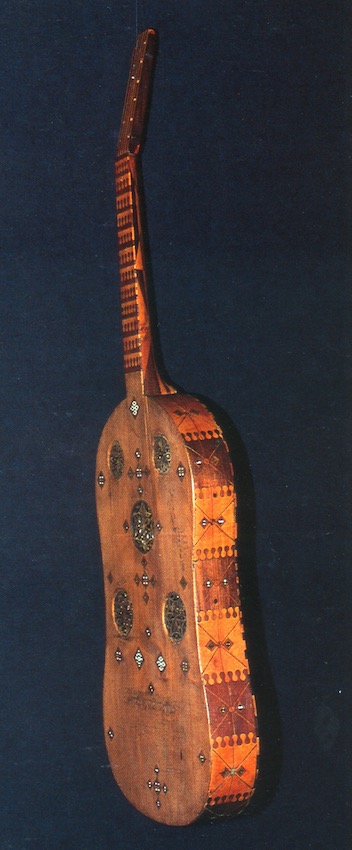Vihuela marked “Guadalupe” held in the Musée Jacquemart André, Paris.
(1525?) - Paris, Musée Jacquemart André.
instrument: vihuela de mano | century: 16cent | catalogue nº: 16-124

Artwork
Creator
Medium Instrument
Location
City Toledo? | Region Castilla-La Mancha | Old kingdom Castile
Characteristics
| Body Waisted | Strings 6 courses | Neck Long | Pegbox Angled flat |
| Bridge Fixed | Frets | Back Flat | Pegs Rear |
| Technique Plucked |
Commentary
The oldest surviving vihuela, this instrument could date from the early 16th century.
6-course vihuela. Detailed measurements and description in Bordás 1991 33ff. Length 1123 mm; two bridge positions indicating mensurs of 757 and 798mm.
The bass side of the pegpox is branded with the word “Guadalupe”, presumably the name of the maker. Possible candidates include Juan Sánchez de Guadalupe (active in Jaén in 1505), Alonso Guadalupe (active in Valencia in 1522), and Juan de Guadalupe (active: Toledo 1525). It is not possible to attribute the instrument to any of these makers or exclude them from possibility.
INSTRUMENT
The instrument was first identified as a vihuela in 1936 by Emilio Pujol. It became the first vihuela known in modern times and was copied for Pujol by Miguel Simplicio. The instrument was first studied by Michael Prynne (prynne1963). The instrument is exceptional on account of its large size and the fact that it made of hundreds of small pieces joined together with great complexity and is an absolute feat of craftsmanship. This has lead to speculation that it may have been made by a craftsman as an examination instrument (on the basis that the examination of violeros included building a vihuela de piezas. It is unclear whether this term refers to an instrument made with separate “pieces” for its back and sides (as opposed to instruments carved from a single block of wood) or to an instrument built using a form of marquetry, and there are differences of opinion among scholars.
The surviving instrument is very large and both of its probable string lengths are in excess of most other instruments. It would be very difficult to use this instrument for the surviving solo vihuela repertory. It could easily have been used as a bass instrument for accompanying the voice or other instruments. Moreover, it is clear from the investigations of Dugot that the neck has also been shortened. An inscription on the soundboard, difficult to read since the instrument was restored by Pierre Abondance in 1980, gives the tuning of the instrument “.... de afinar” as the tuning of a five-course guitar in e, with reentrant tuning of the lower courses, ascending a—d’—g—b—e’. This suggests that this vihuela continued to be used well into the seventeenth century when such tuning was in vogue.
The body shape is of incurved waists with the upper bout slightly narrower than the lower. The pine sound board has five sound holes with rosettes, inlaid coloured taraceas. In its present condition it has no bridge, but there are clearly visible marks showing two different bridge positions. The back is made from 186 triangular pieces in alternating light and dark colour (cypress and rosewood?), radiating from two floral decorations. The neck continues the design idea of the back. The sides are made from interlocking pieces joining with an interlocking keyhole pattern. The fingerboard is based on a related design. The sides are not very deep and the instrument is actually more manageable to hold than might seem.